|
BEAT AND RHYTHM 4Exercises for Rhythm and Syncopation
|
|
|
Get an overview of Musicarta in manageable monthly slices – and keep up to date with new postings.
Read all about it on the Musicarta Newsletter page. The Musicarta News - regular encouragement to learn and progress! Or – get the Musicarta RSS feed. [What’s that?] |
This lesson is just one of the modules in the Musicarta.com ‘Beat and Rhythm’ section. Click up to Beat and Rhythm section directory page here for links to similar material including syncopation and anticipation, reading and writing complicated rhythms and using a simple drum machine (rhythm station).
Reading the Beat Map
The rhythms you will be working with in this module are written down in ‘beat maps’. Here is a diagram that explains what the beat maps show.
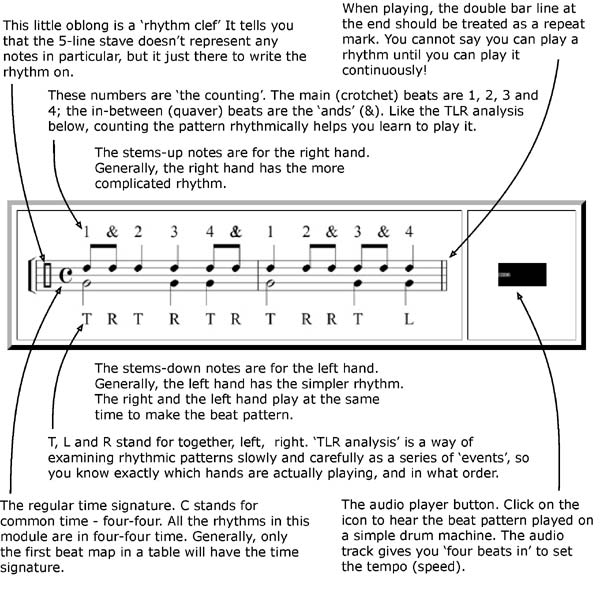
1. Click on the speaker icon to hear the audio file. Read the beat map as you listen to the audio file until you are sure you see how the beat is written.
2. Tap along to the audio track while reading the beat map, then tap to the beat map alone when the audio track stops. NOTE: The double bar line at the end of an example should be treated as a repeat mark. Patterns are not learned until they can be played continuously!
3. Tap a rhythm from the beat map alone, then play the audio file (by clicking on the speaker icon) to see if you are right.
4. Count the rhythm out loud to the audio track. You may find counting out loud awkward at first, but it definitely speeds up your progress, so don’t skip it!
THERead all |
6. Tap your foot a steady four if you can while you do all this, if you can. If you can’t, work at it!
7. Download and print the free hard copy pdf file of these tapping exercises for anytime, anywhere rhythm skills development. Teachers can use the print-outs for a ‘rhythm section’ in any teaching situation.
8. Get into the habit of writing down your own one- and two-bar rhythm patterns. If you want to write down tunes you like or your own compositions, working out and writing down the rhythm and the note values is half the work. You don’t need special paper – ordinary lined paper will do. placed 9. For a challenge, ‘reverse’ the patterns. Play the top rhythm with the left hand and the steady four bottom line with the right hand. The left hand often needs more practice in this line of work.
10. Work hard at not ignoring the counting and TLR (together-left-right) text above and below the beat maps – a great danger when there are music notes to read! It is well proven that viewing rhythmic patterns from counting and TLR perspectives speeds the build-up of rhythmic and syncopation skills.
Table of contents
The tables are arranged overall in order of difficulty, but the Missing Quaver and Dotted Crotchet series can be treated as stand-alones. Link through to individual tables here.
In this module:
In the following modules (opening in THIS window):
- Four quavers in a bar
Four quavers, one anticipation
Combinations including the above
Four quavers, two anticipations
- MINIMS AND CROTCHETS
Click on the audio player in the right hand column to hear the pattern in the beat map.

|
|

|
|

|
|
If you are unsure what to do, click up to the 'Ways to use this material' section here.
- COMBINATIONS OF THE ABOVE
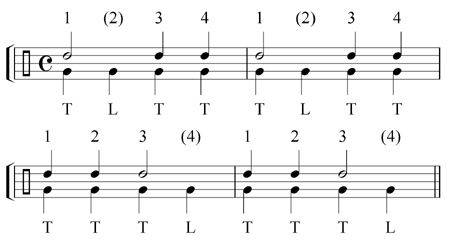
|
|

|
|
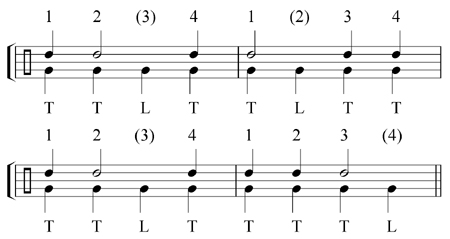
|
|
- ALTERNATIVE LEFT HAND PATTERNS
At this stage, depending on learners’ needs, you may vary the preceding patterns with these new left hand rhythms:

|
|

|
|

|
|
This might generate the following combinations:
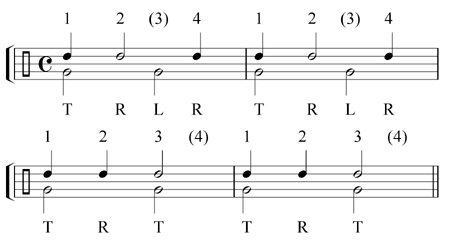
|
|
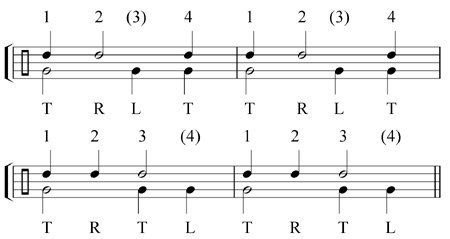
|
|
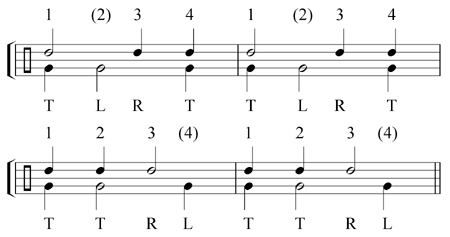
|
|

|
Alternatively, just proceed with the series and save these variations for variety at any later time with any of the right hand patterns.
- TWO QUAVERS IN A BAR

|
|

|
|

|
|

|
- COMBINATIONS

|
|

|
|

|
- COMBINATIONS WITH THE NEW LEFT HAND PATTERNS
Here are some patterns which combine right hands from the ‘Two quavers in a bar’ group with the alternative left hands. The patterns are ‘realised’ – they have notes put to them in little studies. Make sure you can see how the rhythm of the beat map is ‘in’ the study.

|
|

|


|

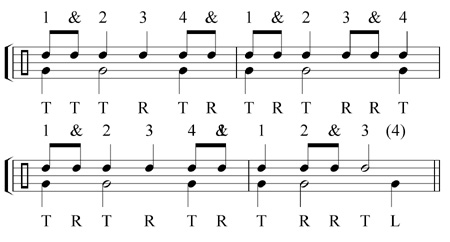
|

These little studies are very like pieces from the graded piano tutors you buy. Teachers and pupils alike can see how valuable practicing the rhythmic pattern of a piece on its own is, and will hopefully include this technique as a routine element of their conventional piano practicing. This is the end of Part One of this Musicarta series. Part Two carries straight on with slightly little more complicated patterns, so make sure you can tap the beat patterns in this module pretty well before going on.
Make a habit of listening for the rhythmic patterns in your favourite popular music, and try to tap out the beat. You don't need any special equipment, and you can be getting better at playing all the time, as your improved rhythmic skills filter through into your playing. Tap on!
This page is one of Musicarta.com’s many free piano lessons online. Click up to the Musicarta home page for an overview of the site and use the tabs on the navbar to access the various section directory pages.
This module is one of Musicarta’s Beat and Rhythm pages. Click up to the Musicarta Beat and Rhythm directory page here to see what else in available to help you add winning rhythms to all your keyboard material.
|
|
Get an overview of Musicarta in manageable monthly slices – and keep up to date with new postings.
Read all about it on the Musicarta Newsletter page. The Musicarta News - regular encouragement to learn and progress! Or – get the Musicarta RSS feed. [What’s that?] |
Thanks for visiting MUSICARTA! Come again soon!
|
|
BEAT AND RHYTHM
|
PUBLICATIONS
exciting digital
home study packs!
BEAT AND RHYTHM
WORKBOOK


12-BAR PIANO
STYLES WORKBOOK


MUSICARTA MODES
WORKBOOK

MUSICARTA EASY
PIANO STYLE

CANON PROJECT

VARIATIONS
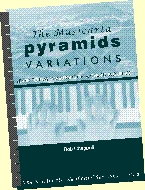
KEY CHORDS VOL.1




YouTube playlists
|
Piano lessons? and keep Musicarta
|






